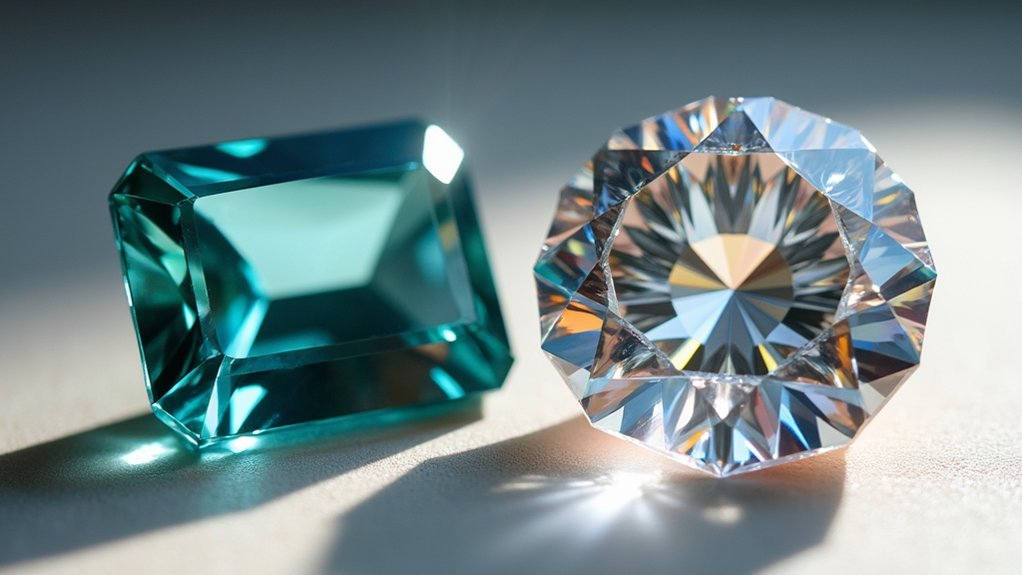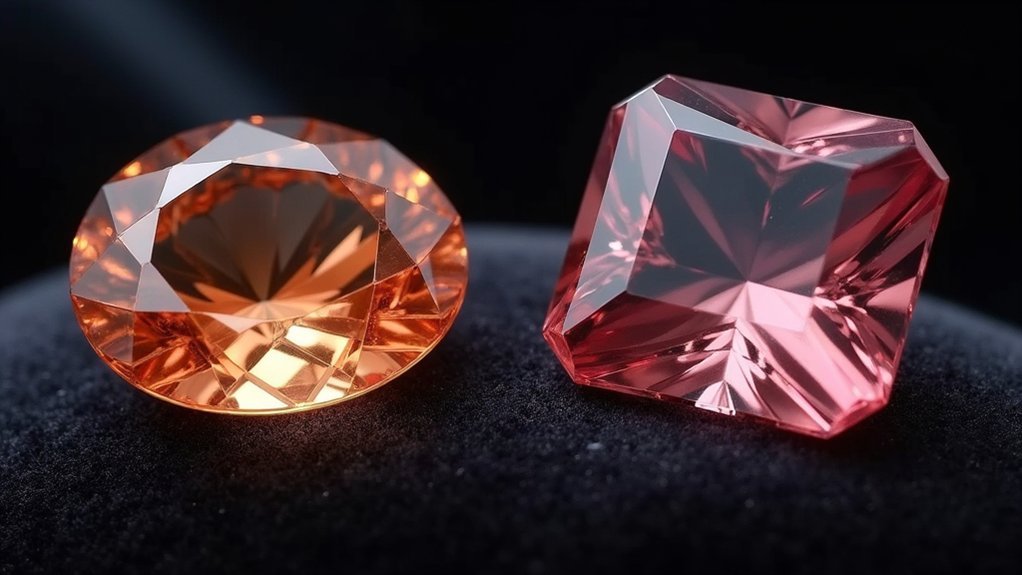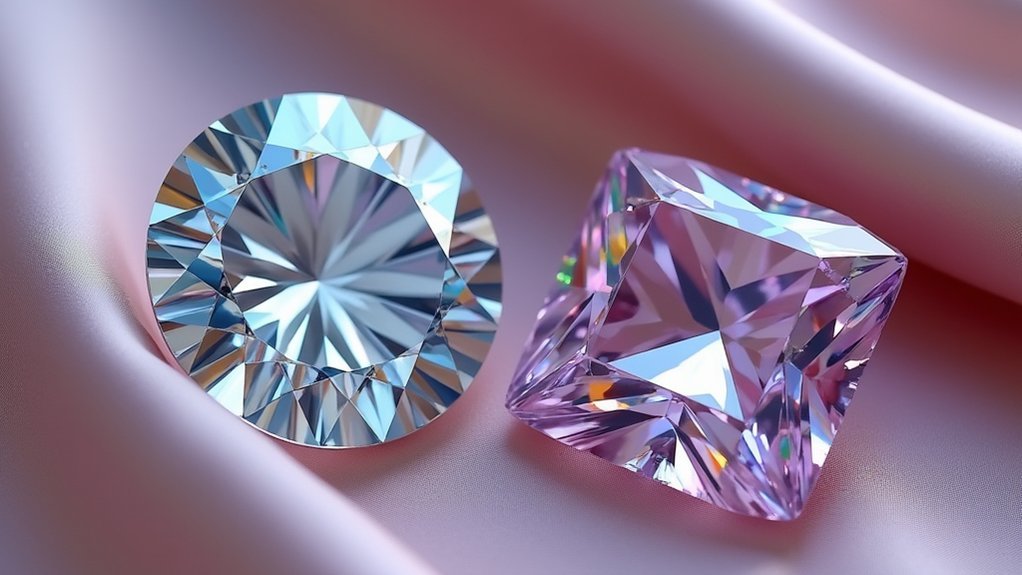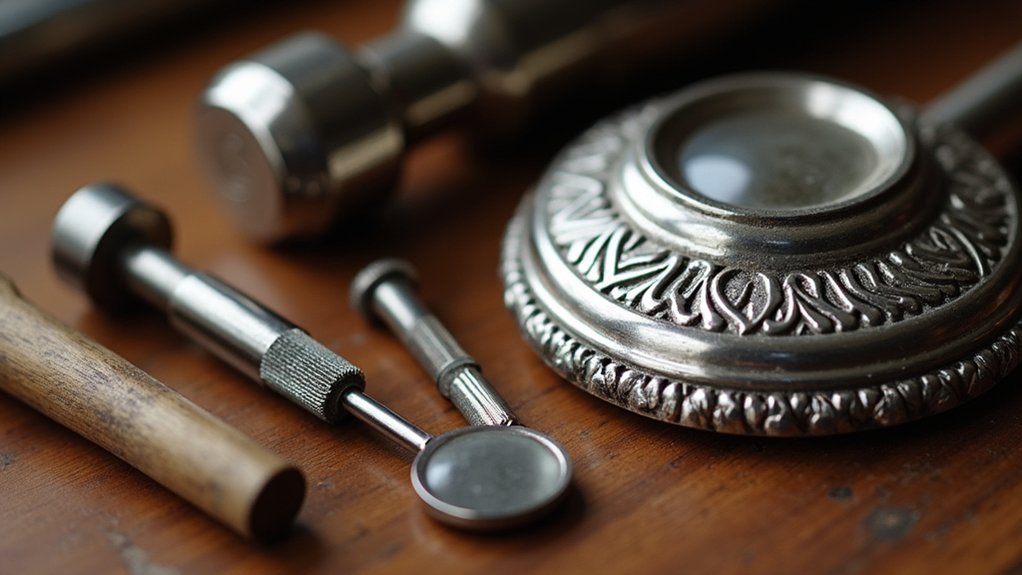You’ll find classic faceting relies on traditional step cuts like emerald and baguette styles that emphasize natural beauty through subtle gleams and elegant proportions. Contemporary approaches use precision brilliant cuts with computer-aided design to maximize light performance and scintillation through calculated facet angles. To bridge both worlds, you can combine historical techniques like rose cuts with modern grading standards, creating unique designs that satisfy collectors seeking individuality while meeting today’s optical performance expectations.
Understanding the Evolution From Step Cuts to Precision Brilliant Techniques

When you examine vintage jewelry pieces, you’ll notice that early gem cutting prioritized showcasing a stone’s natural color and clarity through step cuts—rectangular facets arranged in precise, staircase-like patterns.
These historical cuts, including emerald and baguette styles, represent traditional gem cutting methods that produce subtle gleams rather than intense sparkle.
Traditional cutting techniques like emerald and baguette styles create gentle, sophisticated gleams that prioritize elegance over dramatic brilliance.
You’ll find that modern gem cutters have shifted toward brilliant cuts, applying advanced optical principles to maximize light performance.
Today’s precision cutting techniques allow extraordinary control over facet angles, with modern grading standards demanding table size tolerances of 1.0% and crown angle averages within 0.5°.
This evolution reflects how contemporary approaches prioritize scintillation and brilliance over the understated elegance that step cuts traditionally delivered to discerning collectors.
Comparing Hand Craftsmanship With Computer-Aided Design Methods
Although traditional hand-cutting techniques have dominated gem craftsmanship for centuries, today’s computer-aided design methods are revolutionizing how cutters approach precision work.
You’ll find that hand craftsmanship allows for unique designs and artisan style, where master cutters rely on experience to create complex facets that maximize light performance.
However, CAD technology offers a standardized approach with precise calculations and repeatable results.
When choosing between traditional methods and modern approaches, consider these key differences:
- Hand craftsmanship creates one-of-a-kind pieces with individual character
- Computer-aided design enables detailed light performance simulations before cutting
- Traditional techniques rely on intuition and real-time adjustments
- CAD methods facilitate intricate designs that can be replicated consistently
- Modern technology reduces labor costs while maintaining precision
You’ll discover that each approach serves different market demands and creative goals in gem cutting.
Balancing Historical Rose and Briolette Styles With Modern Named Cuts

While computer-aided design has transformed precision cutting, you’ll find that mastering the balance between historical rose and briolette styles with modern named cuts requires understanding how each approach serves different aesthetic goals.
Rose cuts offer a vintage aesthetic with their faceted tops and flat bases, delivering subdued brilliance perfect for antique-inspired pieces.
Briolette cuts provide teardrop elegance with extensive faceting that bridges Victorian heritage and contemporary designs.
Modern named cuts like Divine and Snowflake incorporate innovative faceting techniques that maximize sparkle through advanced gemology principles.
You can create unique designs by combining these historical styles with contemporary approaches, allowing your craftsmanship to honor traditional methods while embracing cutting-edge innovations that cater to diverse preferences.
Frequently Asked Questions
What Are the Different Types of Gem Faceting?
You’ll encounter brilliant cuts that maximize light return, step cuts with parallel facets, mixed cuts combining both styles, and fantasy cuts featuring curved or concave facets for unique visual effects.
What Are the Three Types of Gem Cutting (Lapidary)?
You’ll encounter three main gem cutting types: brilliant cuts featuring triangular facets for maximum sparkle, step cuts with rectangular facets showcasing clarity, and mixed cuts that combine both styles.
What Is the Difference Between Emerald Cut and Scissor Cut?
You’ll notice emerald cuts feature rectangular step-cut facets emphasizing clarity, while scissor cuts have brilliant triangular facets resembling scissors that maximize sparkle. Emerald cuts showcase color; scissor cuts enhance diamond brilliance.
How Much Does It Cost to Facet a Gem?
You’ll pay $50-$100 for basic faceting of common gemstones, but you’re looking at $200-$300+ for intricate cuts, rare stones, or custom designs requiring specialized equipment and experienced craftsmen.
In Summary
You’ll find that mastering both classic and contemporary faceting approaches gives you the versatility every gem cutter needs. Whether you’re drawn to traditional hand methods or embrace computer precision, there’s value in understanding each technique’s strengths. Don’t feel pressured to choose one style over another—the best cutters blend historical wisdom with modern innovation. Your unique voice emerges when you’re comfortable working across different eras and methods.





Leave a Reply